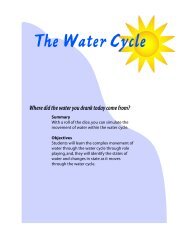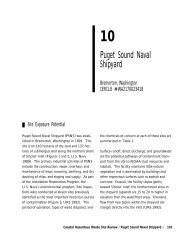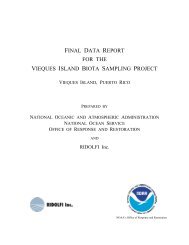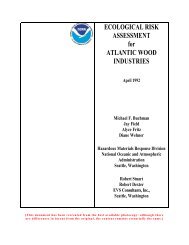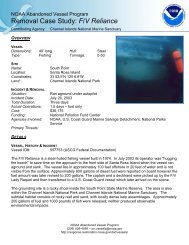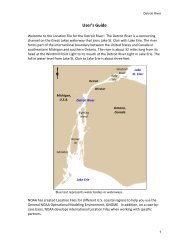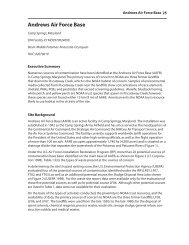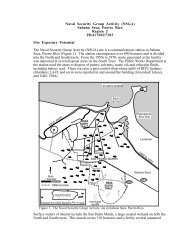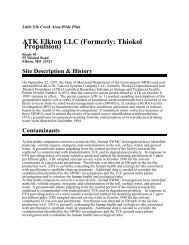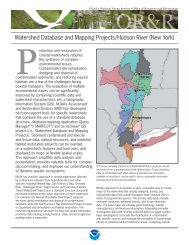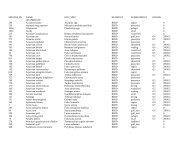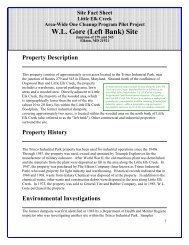The Coastal Resource Coordinator's Bioassessment Manual
The Coastal Resource Coordinator's Bioassessment Manual
The Coastal Resource Coordinator's Bioassessment Manual
Create successful ePaper yourself
Turn your PDF publications into a flip-book with our unique Google optimized e-Paper software.
HAZMAT 93-1–Toxicity Tests<br />
Elutriate tests were originally developed for testing dredged material to simulate conditions<br />
occurring during open-water disposal and are not considered appropriate for testing the<br />
toxicity of in-situ sediments. <strong>The</strong> chemical extraction techniques, used for extraction testing,<br />
remove only certain contaminants so the test organisms are not exposed to the full suite of<br />
contaminants that are actually present in the contaminated sediments. Pore water<br />
techniques require specialized laboratory equipment, and contaminant concentrations may<br />
vary depending on the extraction technique. <strong>The</strong>re are currently no generally accepted<br />
protocols for pore water extraction.<br />
Studies reviewed by Ankley et al. (1991) indicated that pore water exposures provide more<br />
information on sediment toxicity than elutriate exposures. <strong>The</strong>y found that pore water<br />
samples were consistently more toxic than sediment elutriate samples. However, they also<br />
found that pore water samples were sometimes more toxic than bulk sediment samples,<br />
possibly due to pH differences or to the dilution of toxicants by the addition of clean water<br />
to bulk sediment samples (Ankley et al., 1991). Chapman and Fink (1984) also noted<br />
differences between toxicity of bulk sediment and sediment elutriate. Toxicity of bulk<br />
sediment to larval polychaetes was generally greater than that of sediment elutriate.<br />
However, elutriate samples from some stations were toxic, while bulk sediment from the<br />
same stations were not (Chapman and Fink, 1984). Contaminants that have low solubility<br />
in water generally have lower toxicities determined by elutriate tests. Bulk sediment testing<br />
is currently the preferred method for testing sediments at hazardous waste sites to<br />
determine the potential for biological effects at the site. <strong>The</strong> sediment toxicity tests in the list<br />
of recommended toxicity test protocols (Table 8-1) are based primarily on exposures to bulk<br />
sediments.<br />
Selecting a Test Organism<br />
A wide variety of organisms have been used in toxicity tests. <strong>The</strong> most commonly used soil<br />
toxicity tests are the seed germination test (typically using common crop species), the root<br />
elongation test (most often performed with lettuce), and the earthworm test. Freshwater<br />
organisms used for water and sediment toxicity tests include algae (Selenastrum), daphnids,<br />
chironomids, amphipods, and fish (especially fathead minnow and rainbow trout). <strong>The</strong><br />
most commonly tested marine and estuarine organisms are amphipods, mysids, and bivalve<br />
or echinoderm larvae. Luminescent bacteria have also been used in tests of water, sediment,<br />
and soil.<br />
3-7 August 1997



